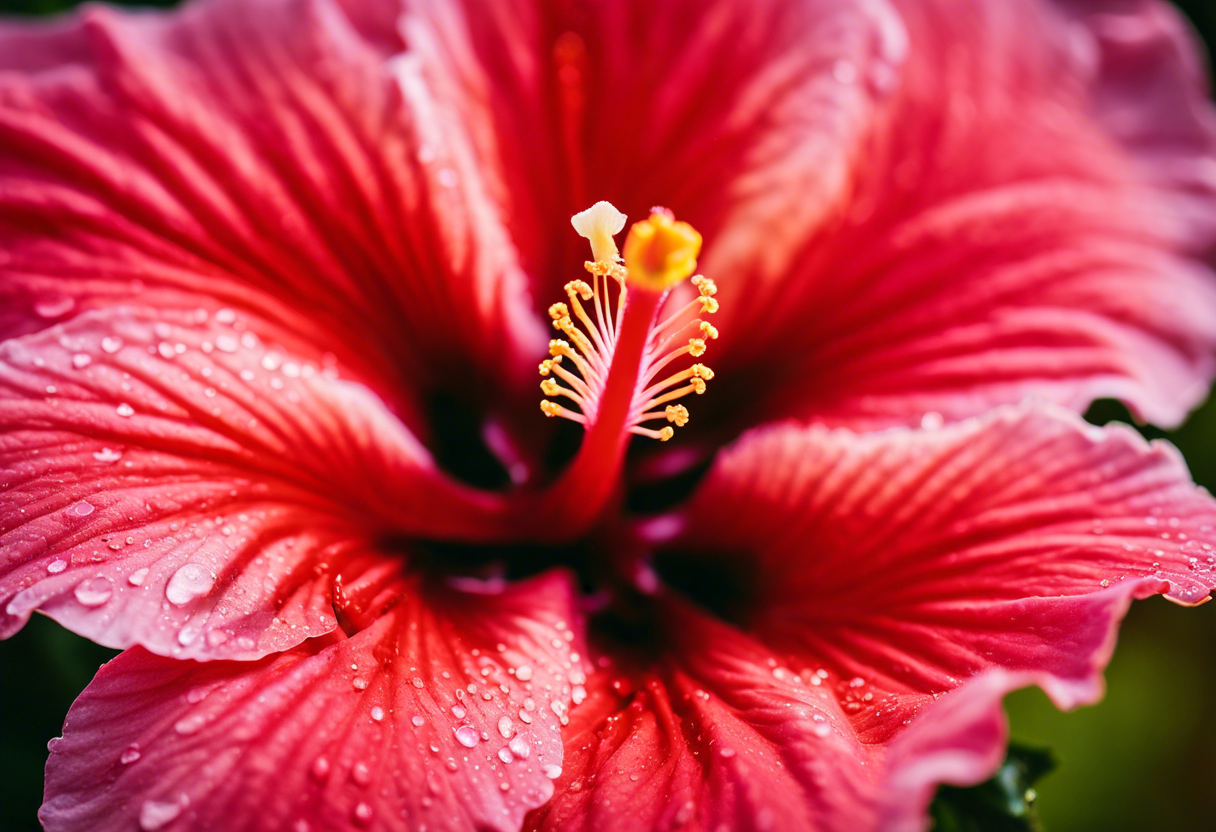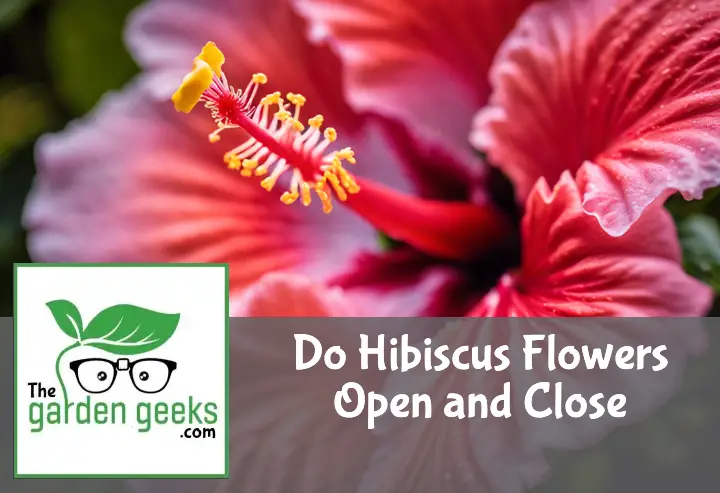Ever found yourself sipping on a refreshing hibiscus tea and wondered, Do Hibiscus Flowers Open and Close? Well, you’re not alone. It’s a question that has intrigued many a curious mind.
In this blog post, we’ll dive into the fascinating world of these vibrant blooms. We’ll explore their unique behaviors and the factors influencing them. So buckle up, flower enthusiasts! This is going to be one blooming good read!
Key Takeaways
- Yes, hibiscus flowers do open and close.
- They typically open in the early morning and close in the late afternoon or evening.
- This phenomenon is known as nyctinasty, a type of plant movement that responds to light or temperature changes.
- The opening and closing of hibiscus flowers are not affected by indoor or outdoor conditions but rather by their biological clock.
What are Hibiscus Flowers?
Hibiscus flowers, you’ve probably seen ’em. They’re those big, showy blooms that scream “tropical paradise.” But there’s more to these plants than just being pretty. Let’s dive into the world of hibiscus flower description and facts.
Brief Overview of Hibiscus Flowers
So, what exactly is a hibiscus? Well, it’s a type of flowering plant in the mallow family. The size of hibiscus flowers can vary, but they’re generally quite large and eye-catching. Their colors? Oh boy, they come in a rainbow of hues – from white to pink to red to yellow and even blue!
These beauties aren’t just for looks though. Uses of hibiscus flowers extend beyond their ornamental value. You might have sipped on some hibiscus tea or used products with hibiscus extract in them. Yep, these flowers are edible and have medicinal properties too!
Different Types of Hibiscus Flowers
Now onto the different types of these bloomin’ beauties! There are hundreds of species out there, but we’ll stick to the basics here.
First up is the tropical hibiscus. These guys love warm climates (hence the name) and produce vibrant blooms that can make any garden feel like an island getaway.
Then we’ve got hardy hibiscuses. These tough cookies can withstand colder temperatures and still put on a great floral show.
And let’s not forget about all the different colors! From fiery reds to cool blues, there’s a different color of hibiscuses for every mood and setting.
Do Hibiscus Flowers Open and Close?

Well, here’s the scoop. Do Hibiscus Flowers Open and Close? You bet they do! It’s a fascinating dance of nature that never fails to amaze.
Understanding the Opening and Closing Mechanism of Hibiscus Flowers
Now, let’s dive into the nitty-gritty. The hibiscus bloom cycle is a marvel of flower opening mechanism. These beauties are what we call diurnal flowers. That means they open up with the sunrise and close at sunset, following their own little plant circadian rhythms.
The magic behind this lies in the hibiscus’s biology. As sunlight hits the flower, it triggers a response that makes it unfurl its petals. When night falls, it’s time for some shut-eye, so our hibiscus folds back up again.
Factors Influencing the Opening and Closing of Hibiscus Flowers
But hey, it ain’t just about day and night! There are other factors at play too. For instance, environmental conditions can have a big impact on when these flowers decide to show off their colors.
Sunlight is obviously a biggie. More light equals more blooming action! But temperature also plays a role in this floral ballet. If it’s too hot or too cold, our hibiscus might decide to hit snooze on its alarm clock.
And let’s not forget about genetics! Just like you’ve got your momma’s eyes or your dad’s sense of humor, hibiscuses inherit certain traits from their parent plants that can affect their blooming habits.
Main Topic 3: Why do Hibiscus Flowers Open and Close?
Ever wondered, ‘Do Hibiscus Flowers Open and Close?’ Well, the answer is a resounding yes! This fascinating behavior in hibiscus flowers is influenced by two main environmental factors – light and temperature.
Subtopic 3.1: The Role of Light in the Opening and Closing of Hibiscus Flowers
Now let’s shed some light on this topic (pun intended). You see, hibiscus flowers are like sun worshippers. They thrive on daylight and respond to it by opening up their beautiful petals. This phenomenon is known as photoperiodism in hibiscus.
But it’s not just any light that gets them going. Nope, these beauties are all about quality over quantity. They prefer the soft, warm glow of morning sunlight to kickstart their day. So, if you’re an early riser, you’ll get to witness the spectacular sight of hibiscus flowers blooming at dawn.
As dusk approaches though, they start winding down for the day. The diminishing light signals bedtime for these floral divas, leading to the closing of flowers.
Subtopic 3.2: The Impact of Temperature on the Opening and Closing of Hibiscus Flowers
Moving onto temperature now – another key player in this floral drama. Just like us humans, hibiscus flowers also have their comfort zones when it comes to temperature.
When things heat up during midday, they might decide to take a little siesta by partially closing their petals. This behavior is part of what we call thermoperiodism in hibiscus.
On the flip side, if it gets too chilly outside (think winter mornings), they might just choose to stay tucked in bed a little longer (who can blame them?). Yes folks, the cold can affect flower closure.
So there you have it – the secret lives of hibiscus flowers. They open and close in response to light and temperature changes, making them some of nature’s most captivating performers!
Main Topic 4: How does the Opening and Closing Affect the Life Cycle of a Hibiscus Flower?
The opening and closing mechanism of hibiscus flowers plays a crucial role in their life cycle. It’s like a well-choreographed dance, ensuring survival and continuation of the species.
Subtopic 4.1: The Relationship between Flowering Time and Pollination
Ever wondered why hibiscus blooms at specific times? Well, it’s all about timing! The flowering time is closely linked to the hibiscus pollination process. When the flower opens, it’s like a dinner bell for pollinators. They come buzzing in, helping with fertilization and ensuring that there’ll be more hibiscus plants in the future.
Subtopic 4.2: How this Mechanism Contributes to Plant Survival
Now let’s talk about survival, baby! The opening and closing mechanism isn’t just for show. It’s vital for hibiscus plant survival. By closing up at night or during harsh weather, hibiscuses protect their delicate parts from damage. This clever tactic helps them live to bloom another day! So next time you see a hibiscus flower open up, remember – it’s not just beauty, it’s also brains!
To Wrap Up
So, just like a teenager who loves to sleep in, Do Hibiscus Flowers Open and Close? You bet they do! These floral divas love their beauty sleep but bloom brightly when it’s showtime.
Remember, your hibiscus is not being lazy or stubborn; it’s just following its natural rhythm. So, let’s give them the standing ovation they deserve for their spectacular daily performance!


